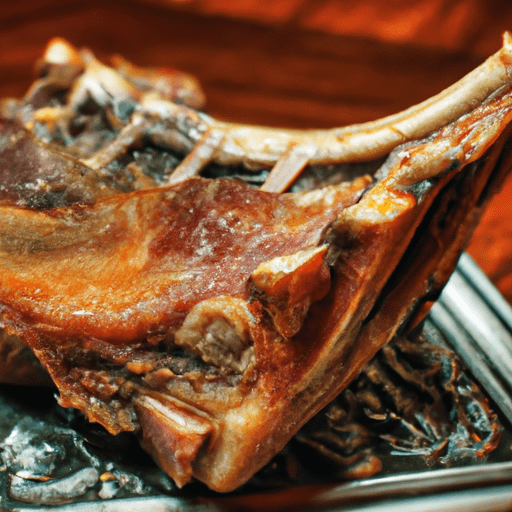The Magnificent Pork Crown Roast: A Feast Fit for a King
If you are searching for a show-stopping centerpiece for your next special occasion, look no further than the majestic pork crown roast. This regal cut of meat not only impresses with its elegant presentation, but it also tantalizes the taste buds with its succulent and tender meat. In this blog post, we will delve into the world of pork crown roasts, exploring its taste, common uses in cooking, nutritional value, and share some intriguing history and facts about this culinary masterpiece.
The Taste of Royalty
Pork crown roast boasts a delightful combination of rich flavors and succulence. The meat, which is sourced from the rib section of the pig, is known for its exceptional tenderness and juiciness. With a higher fat content than other cuts, it becomes incredibly flavorful when cooked properly, making it an absolute delight for meat lovers.
When roasted to perfection, the pork crown roast delivers a juicy and mouthwatering experience. The outer layer of fat, when rendered during cooking, envelopes the meat, creating a stunningly golden and beautifully crisp crust. The meat inside remains tender and juicy, with a subtle sweetness that pairs well with a variety of flavors.
Versatile and Elegant Usage
Pork crown roasts are versatile in how they can be prepared and served. They are often reserved for special occasions and celebratory feasts, wowing guests with their eye-catching appearance and divine taste.
Traditionally, the cavity of the roast is often filled with a delectable stuffing made from herbs, breadcrumbs, dried fruits, or even a combination of savory and sweet ingredients. This stuffing enhances the flavors of the roast and adds an element of surprise when sliced.
Aside from stuffing, the pork crown roast can be seasoned with a plethora of herbs, spices, and marinades, allowing for creative customization to suit your personal tastes. The succulent meat pairs beautifully with both bold and delicate flavors, making it an ideal canvas for culinary experimentation.
Nutritional Value
Like all cuts of pork, the crown roast is a good source of high-quality protein. It contains essential vitamins and minerals, including vitamin B-12, zinc, and selenium. While it is moderately high in fat, the majority of it is monounsaturated and polyunsaturated fats, which are heart-healthy when consumed in moderation.
To achieve a healthier preparation, it is recommended to trim excess fat and choose leaner cuts within the crown roast. This helps to lower the overall fat content while maintaining its extraordinary flavor.
A Regal History
The pork crown roast has a captivating history that is closely intertwined with European culinary traditions. It is believed to have originated in the kitchens of France, where extravagant feasts were a symbol of wealth and power.
During medieval times, the pork crown roast was a favorite amongst nobility, often served at grand banquets and royal courts. Its regal presentation, resembling a crown with the rib bones meticulously frenched and arranged in a circular form, further added to its allure.
Interesting Facts
To wrap up our exploration of the pork crown roast, here are some intriguing facts about this majestic cut:
- A standard pork crown roast typically consists of 12 to 16 ribs, but larger roasts can reach up to 28 ribs.
- The French term for a pork crown roast is “côtelette à la Régence,” named after the commission in charge of royal banquets during the reign of King Louis XV.
- In the United States, the pork crown roast gained popularity in the mid-20th century, becoming a classic holiday and celebratory dish.
Conclusion
The pork crown roast is an opulent centerpiece that will transform any gathering into a sumptuous feast fit for royalty. With its succulent taste, versatility, and captivating history, it promises to leave a lasting impression on both your guests and taste buds. So why not add a touch of elegance and grandeur to your next special occasion with this culinary masterpiece? Your guests will undoubtedly be in awe of the magnificent pork crown roast.
Pork Crown Roast
Origin: The pork crown roast is believed to have originated in the United States. It is a popular centerpiece dish in American cuisine, especially during festive occasions such as Thanksgiving or Christmas.
Common Uses: A pork crown roast is typically made by arranging several bone-in pork loin rib chops into a circular shape to form a crown. It is often prepared by seasoning the meat with herbs, spices, and sometimes a stuffing, then roasted until golden brown and cooked through. The crown roast can be served with various sides and garnishes, such as roasted vegetables or cranberry sauce.
Nutritional Benefits: Pork crown roast can be a good source of protein and various vitamins and minerals. It provides essential nutrients such as iron, zinc, and B vitamins. However, it is important to note that the specific nutritional content may depend on the cut of meat and preparation method.
Unique Properties: The unique visual appeal of the pork crown roast, with its bone-in rib chops forming a crown shape, makes it an eye-catching dish for special occasions. Its presentation often adds a touch of elegance and grandeur to the dining table.
Historical Significance: The concept of the crowned roast has been around for centuries. Similar preparations can be traced back to medieval European feasts and banquets, where various types of roasted meats were showcased. The influence of European culinary traditions eventually led to the development of the pork crown roast in the United States, where it became especially popular during the mid-20th century.




Use the share button below if you liked it.
It makes me smile, when I see it.